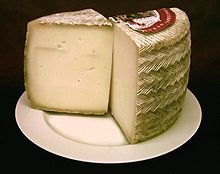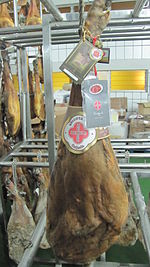Spain Ham is the best, well known as JAMON IBERICO, whos best is DE BELLOTA(ACORN).
Production
The black Iberian pig lives primarily in the central and southwestern region of the Iberian Peninsula, which includes both Portugaland Spain. In Spain, the Black Iberian Pig is typically found in the provinces of Salamanca, Ciudad Real, Cáceres, Badajoz(Protected Denomination of Origin Dehesa de Extremadura), Seville, Córdoba (Protected Denomination of Origin Valle de Los Pedroches) and Huelva (Denomination of Origin Huelva). In Portugal the central and southern regions have an abundance of this species, with a predilection for the Alentejo region. In Portugal, the Black Iberian Pig is commonly referred to as porco preto ibéricoor porco alentejano. The Black Iberian Pig is ingrained in the local Portuguese culture and tradition, with annual festivals in their honor, such as the Feira do Porco Preto, an annual festival in the region of Ourique.
Immediately after weaning, the piglets are fattened on barley and maize for several weeks. The pigs are then allowed to roam in pasture and oak groves to feed naturally on grass, herbs, acorns, and roots, until the slaughtering time approaches. At that point, the diet may be strictly limited to olives or acorns for the best quality jamón ibérico, or may be a mix of acorns and commercial feed for lesser qualities.
The hams from the slaughtered pigs are salted and left to begin drying for two weeks, after which they are rinsed and left to dry for another four to six weeks. The curing process then takes at least twelve months, although some producers cure their jamones ibéricos for up to 48 months.
In particular, the ibérico hams from the towns of Guijuelo in the Salamanca province and Jabugo in the Huelva province have their ownDenominación de Origen. Almost the entire town of Jabugo is devoted to the production of jamón ibérico; the biggest producer is 5J Sánchez Romero Carvajal. The town's main square is called La plaza del Jamón.
Types and characteristics[edit]
The hams are labeled according to the pigs' diet and the percentage of the pigs' Iberian ancestry, with an acorn diet and pure-bred Iberians being most desirable. The current labeling system, based on a series of color-coded labels, was phased in starting in January 2014.[1]
- The finest is called jamón ibérico de bellota (acorn). This ham is from free-range pigs that roam oak forests (called dehesas) along the border between Spain and Portugal, and eat only acorns during this last period. It is also known as jamón ibérico de Montanera. The exercise and diet have a significant impact on the flavor of the meat; the ham is cured for 36 months. This grade is divided into two subtypes:
- Black label — Identifies jamón 100% ibérico de bellota produced from pure-bred Iberian pigs fed as above.
- Red label — Identifies jamón ibérico de bellota from free-range pigs that are not pure-bred, but also fed exclusively on acorns during the final period. Since 2014, the percentage of Iberian ancestry in the animal must be specified on the label.
- The next grade is called jamón ibérico cebo de campo. This ham is from pigs that are pastured and fed a combination of acorns and grain. As of 2014, this ham bears a green label.
- The third type is called jamón ibérico de cebo, or simply, jamón ibérico. This ham is from pigs that are fed only grain. The ham is cured for 24 months. As of 2014, this ham bears a white label.
Additionally, the word puro (pure, referring to the breed) can be added to the previous qualities when both the father and mother of the slaughtered animal are of pure breed and duly registered on the pedigree books held by official breeders. Also, images of acorns anddehesas on product labels are restricted to hams that qualify as bellota.[1] The current labeling system also applies to paleta (front legs, with jamón coming from the hind leg) and caña de lomo (loin) cuts from Iberian pigs.[1]
The term pata negra is also used to refer to jamón ibérico in general, and may refer to any one of the above three types. The term refers to the color of the pigs' nails, which are white in most traditional pork (Sus domesticus) breeds, but black for the Black Iberian breed. While as a general rule, a black nail should indicate an Ibérico ham, there are cases of counterfeits, with the nails being manually painted.
Jamones de bellota are prized both for their smooth texture and rich, savory taste. A good ibérico ham has regular flecks of intramuscular fat (marbling).
The fat content is relatively high compared to jamón serrano, thus giving a rich taste.
Availability in the United States[edit]
Until 2007, jamón ibérico was not available in the United States (a fact referenced in the movie Perdita Durango, where the ham of Jabugois praised as "illegal, but delicious").
Prior to 2005, only pigs raised and slaughtered outside of Spain were allowed to be processed in Spain for export to the United States. In 2005, the first slaughterhouse in Spain, Embutidos y Jamones Fermín, S.L. (Salamanca), was approved by the United States Department of Agriculture to produce ibérico ham products for export to the United States.
The first jamones ibéricos were released for sale in the United States in December 2007, with the bellota hams due to follow in July 2008. The basic jamón ibérico is priced upwards of $52 a pound, and the bellota is priced upwards of $96 a pound, making these hams some of the most expensive in the world.
**Source: WikiPedia
Where to buy:
MUSEO DEL JAMON
EXTREMADURA
HUELVA
INTRODUCING ''QUESO MANCHEGO'' (CHEESE):
Manchego
From Wikipedia, the free encyclopedia
| Manchego | |
|---|---|
 | |
| Other names | None |
| Country of origin | Spain |
| Region | La Mancha |
| Source of milk | sheep |
| Texture | Firm and compact |
| Fat content | 6.5% min |
| Protein content | 4.5% min |
| Dimensions | max height 12 cm max diameter 22 cm |
| Weight | min 0.4 kg, max 4.0 kg |
| Aging time | min 60 days, max 2 years |
| Certification | PDO |
Manchego (officially Spanish: queso manchego, pronounced: [ˈkeso maɲˈtʃeɣo]) is a cheese made in the La Mancha region of Spainfrom the milk of sheep of the manchega breed. Official manchego cheese is to be aged for between 60 days and two years.
Manchego has a firm and compact consistency and a buttery texture, and often contains small, unevenly distributed air pockets. The colour of the cheese varies from white to ivory-yellow, and the inedible rind from yellow to brownish-beige. The cheese has a distinctive flavour, well-developed but not too strong, creamy with a slight piquancy, and leaves an aftertaste that is characteristic of sheep’s milk.
The designation queso manchego is protected under Spain's Denominación de Origen (DO) regulatory classification system,[1] and the cheese has been granted Protected Designation of Origin (PDO) status by the European Union.[2]
**Source: WikiPedia
Where to buy:
EL CORTE INGLES
CASTILLA LA MANCHA




No hay comentarios:
Publicar un comentario